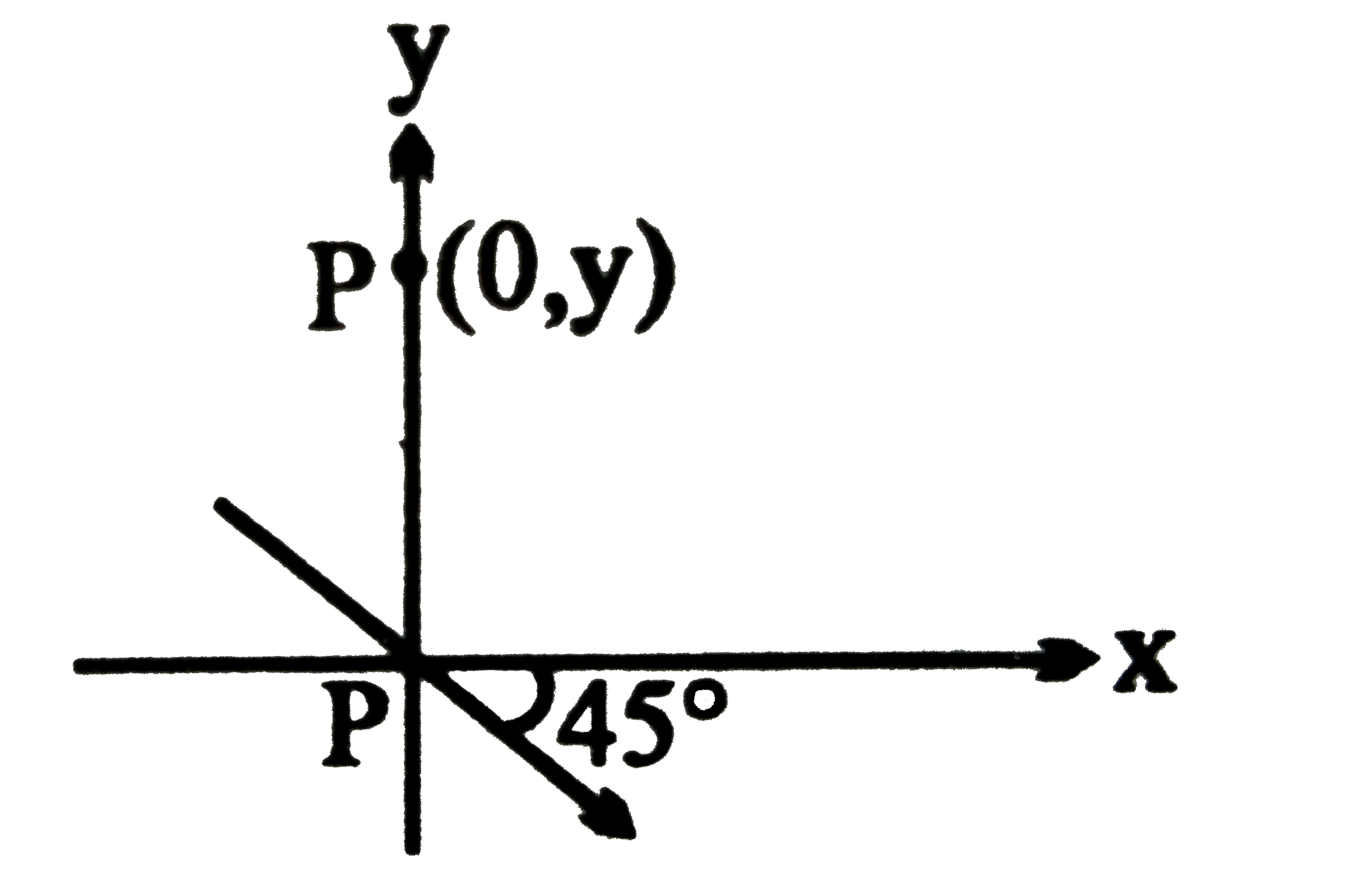A short magnetic dipole when placed at origin with its dipole moment oriented along x-axis , the magnetic field at the point (a,0) is →B . What will be the magnetic field at the above point , if another identical dipole is also placed at origin with its dipole moment oriented along y-axis ?
To solve the problem, we need to find the resultant magnetic field at the point (a, 0) due to two identical magnetic dipoles placed at the origin. One dipole has its moment oriented along the x-axis, and the other has its moment oriented along the y-axis.
1. Magnetic Field Due to the First Dipole (along x-axis):
- The magnetic field →B at a point due to a magnetic dipole moment →m at a distance r is given by:
→B=μ04π⋅2→mr3
- Here, the dipole moment →m for the first dipole is along the x-axis, so we can write:
→B=μ04π⋅2ma3^i
- This is the magnetic field →B at the point (a, 0).
2. Magnetic Field Due to the Second Dipole (along y-axis):
- For the second dipole, which is oriented along the y-axis, the magnetic field at the same point (a, 0) is given by:
→B′=μ04π⋅ma3(−^j)
- This is because the point (a, 0) is a side-on position for the dipole oriented along the y-axis.
3. Resultant Magnetic Field:
- The net magnetic field →Bnet at the point (a, 0) due to both dipoles is the vector sum of →B and →B′:
→Bnet=→B+→B′
- Substituting the expressions we found:
→Bnet=μ04π⋅2ma3^i+(−μ04π⋅ma3^j)
4. Magnitude of the Resultant Magnetic Field:
- The resultant magnetic field can be calculated using the Pythagorean theorem since the two components are perpendicular:
|→Bnet|=√(μ04π⋅2ma3)2+(−μ04π⋅ma3)2
- Simplifying this:
|→Bnet|=√(μ04πa3)2(4m2+m2)=√(μ04πa3)2⋅5m2
- Thus,
|→Bnet|=μ04πa3√5m
5. Expressing in terms of B:
- Since we know that B=μ04π⋅2ma3, we can express m in terms of B:
m=B⋅4πa32μ0
- Substituting this back into the expression for |→Bnet|:
|→Bnet|=√5⋅B2
Final Result:
Thus, the resultant magnetic field at the point (a, 0) when both dipoles are present is:
|→Bnet|=√52B
- The magnetic field →B at a point due to a magnetic dipole moment →m at a distance r is given by:
→B=μ04π⋅2→mr3
- Here, the dipole moment →m for the first dipole is along the x-axis, so we can write:
→B=μ04π⋅2ma3^i
- This is the magnetic field →B at the point (a, 0).
- For the second dipole, which is oriented along the y-axis, the magnetic field at the same point (a, 0) is given by:
→B′=μ04π⋅ma3(−^j)
- This is because the point (a, 0) is a side-on position for the dipole oriented along the y-axis.
- The net magnetic field →Bnet at the point (a, 0) due to both dipoles is the vector sum of →B and →B′:
→Bnet=→B+→B′
- Substituting the expressions we found:
→Bnet=μ04π⋅2ma3^i+(−μ04π⋅ma3^j)
- The resultant magnetic field can be calculated using the Pythagorean theorem since the two components are perpendicular:
|→Bnet|=√(μ04π⋅2ma3)2+(−μ04π⋅ma3)2
- Simplifying this:
|→Bnet|=√(μ04πa3)2(4m2+m2)=√(μ04πa3)2⋅5m2
- Thus,
|→Bnet|=μ04πa3√5m
- Since we know that B=μ04π⋅2ma3, we can express m in terms of B:
m=B⋅4πa32μ0
- Substituting this back into the expression for |→Bnet|:
|→Bnet|=√5⋅B2
Thus, the resultant magnetic field at the point (a, 0) when both dipoles are present is:
|→Bnet|=√52B
Topper's Solved these Questions
- BOOK - AAKASH INSTITUTE ENGLISHCHAPTER - MAGNETISM AND MATTER EXERCISE - Try Yourself53videos
MAGNETISM AND MATTER
- BOOK - AAKASH INSTITUTE ENGLISHCHAPTER - MAGNETISM AND MATTER EXERCISE - Assignment Section - A Objective Type Questions (One option is correct)58videos
MAGNETISM AND MATTER
- BOOK - AAKASH INSTITUTE ENGLISHCHAPTER - LAWS OF MOTIONEXERCISE - Assignment (SECTION-D) (Assertion-Reason Type Questions)15videos
LAWS OF MOTION
- BOOK - AAKASH INSTITUTE ENGLISHCHAPTER - MECHANICAL PROPERTIES OF FLUIDSEXERCISE - SECTION - J9videos
MECHANICAL PROPERTIES OF FLUIDS
Similar Questions
A small electric dipole is placed at origin with its dipole moment directed along positive x-axis .The direction of electric field at point (2,2√2,0)
View SolutionTwo short dipoles, each of diple moment p , are placed at origin. The dipole moment of one dipole is along x-axis, while that of other is along y-axis . The electric field at a point (a,0) is given by
View SolutionAn electric dipole is placed along x-axis with its centre at origin:
View SolutionA dipole is placed at the origin such that its dipole moment is →p=−pˆi, The electric field and potential at (0,d,0) respectively are :
View SolutionA dipole is placed at origin of coordinate system as shown in figure, find the electric field at point P(0,y)
 .View Solution
.View SolutionA magnetic of magnetic moment placed along the X-axis in an magnet field .Find the torque acting on the magnetic field
View SolutionAn electric dipole is placed at origin in the xy plane with its orientation along the positive x-axis. The direction is electric field .
View SolutionAn electric dipole is placed at the origin along x-axis.The electric field at any point , whose position vector , makes an angle θ with the x-axis ,makes an angle,
View SolutionA magnetic dipole is placed in a uniform magnetic field of intensity B, oriented along the direction of the field. If the magnetic dipole moment is M, then the maximum work an external agent can perform in rotating the dipole will be
View SolutionA megnetic dipole with a dipole moment of magnitude 0.020JT is released from rest in a tutiliform magnetic field of magnitude 52mT. The rotation of the dipole due to the magnetic force on it is unimpeded. When the dipole rotates through the orientations where its dipole moment is aligned with the magnetic field, its kinetic energy is 0.80mJ.
(a) What is the initial angle between the dipole moment and the magnetic field?
(b) What is the angle when the dipole is next (momentarily) at rest?View Solution

